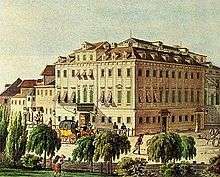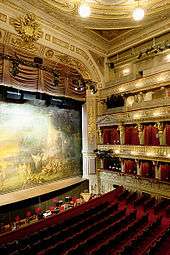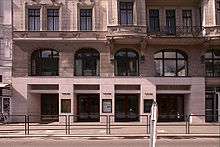Theater an der Wien
|
| |
| Location | Vienna |
|---|---|
| Owner | Vereinigte Bühnen Wien |
| Type | Opera house |
| Opened | 13 June 1801 |
| Website | |
|
www | |
The Theater an der Wien is a historic theatre in Vienna located on the Left Wienzeile in the Mariahilf district. Completed in 1801, the theatre has hosted the premieres of many celebrated works of theatre, opera, and symphonic music. Since 2006, it has served primarily as an opera house, hosting its own company.
Although "Wien" is German for "Vienna", the "Wien" in the name of the theatre is actually the name of the Wien River, which once flowed by the theatre site; "an der Wien" means "on the banks of the Wien". In modern times, the river has been covered over in this location and the covered riverbed now houses the Naschmarkt, an open-air market.
The theatre is operated in cooperation with Vereinigte Bühnen Wien (VBW) which also operates the Raimund Theater and the Ronacher.
History
Early history

The theatre was the brainchild of the Viennese theatrical impresario Emanuel Schikaneder, who is best known as Mozart's librettist and collaborator on the opera The Magic Flute (1791). Schikaneder's troupe had already been successfully performing for several years in Vienna in the smaller Theater auf der Wieden and this is where The Magic Flute had premiered. As the troupe's performances often emphasized spectacle and scenery, the librettist felt ready to move to a larger and better equipped venue.[1]
He had already been granted an imperial licence to build a new theatre in 1786, but it was only in 1798 that he felt ready to act on this authorization. The building was designed by the architect Franz Jäger in Empire style (it has since been remodeled). Construction was completed in 1801. The theatre has been described as "the most lavishly equipped and one of the largest theatres of its age.".[2]

The theatre opened on 13 June 1801 with a prologue written by Schikaneder followed by a performance of the opera Alexander by Franz Teyber. The new theatre proved to be a sensation. Adolf Bäurle, a local critic, wrote "if Schikaneder and [his partner] Zitterbarth had had the idea ... to charge admission simply for looking at the glories of their Theater an der Wien, Schikaneder would certainly have been able to take in vast sums of money without giving one single performance." The Allgemeine musikalische Zeitung called it the "most comfortable and satisfactory in the whole of Germany" (which meant at the time, "all German-speaking lands").[3]
In 1807 the theatre was acquired by a group of court nobles that included Count Ferdinand Palffy von Erdöd, who bought it outright in 1813. During the period of his proprietorship, which lasted until 1826, he offered opera and ballet and, to appeal to a wider Viennese audience, popular pantomime and variety acts, losing money in elaborate spectacles until finally he was forced to sell the theatre at auction in 1826.
Only a part of the original building is preserved: the Papagenotor (Papageno Gate) is a memorial to Schikaneder, who is depicted playing the role of Papageno in The Magic Flute, a role he wrote for himself to perform. He is accompanied by the Three Boys, characters in the same opera.
In the late 19th to early 20th centuries, the theatre experienced a golden age during the flourishing of Viennese operetta, as referenced in the list below.
Later history

From 1945 to 1955, it was one of the temporary homes of the Vienna State Opera, whose own building had been destroyed by Allied bombing during World War II. However, in 1955, the theatre was closed for safety reasons. It languished unused for several years, and by the early 1960s, the threat had emerged that it would be converted to a parking garage. (This was the same era of "urban renewal" that in America nearly destroyed Carnegie Hall).
Fortunately, in 1962 the theatre found a new and successful role for itself as a venue for contemporary musical theatre. Many English-language musicals had their German premieres there. In 1992, the musical Elisabeth (about Franz Joseph I of Austria's wife, Elisabeth of Bavaria, also known as Sissi), premiered there. The musical Cats directed and choreographed by Gillian Lynne played successfully for seven years.
Despite its focus on operettas and musicals, the theatre still served as a venue for occasional opera productions, especially during the Vienna Festival seasons, and sometimes co-produced with the Vienna State Opera. Notable productions of the non-standard repertory were Lulu (1962; conducted by Karl Böhm, staged by Otto Schenk, designed by Caspar Neher, starring Evelyn Lear); Haydn's Orfeo ed Euridice (1967; conducted by Richard Bonynge, staged by Rudolf Hartmann, with Nicolai Gedda, Joan Sutherland); Il ritorno d'Ulisse in patria (1971; conducted by Nikolaus Harnoncourt, staged by Federik Mirdita); La clemenza di Tito (1976; conducted by Julius Rudel, staged by Mirdita, with Werner Hollweg, Teresa Berganza, Arleen Augér, Edda Moser), Fierrabras (1988; conducted by Claudio Abbado, staged by Ruth Berghaus, with Thomas Hampson, Karita Mattila, László Polgár); and the world premiere of Adriana Hölszky's Die Wände (1995; conducted by Ulf Schirmer, staged by Hans Neuenfels). Between 1996 and 2002, Riccardo Muti conducted new productions of the three da Ponte operas of Mozart, based on an original production by Giorgio Strehler).
Today
In 2006, the 250th anniversary year of Mozart's birth, the Theater an der Wien presented a series of major Mozart operas, thus initiating its conversion to a full-time venue for opera and other forms of classical music under the direction of Roland Geyer. Major musical productions since are now presented at either the Raimund Theater or the Ronacher. The first opera to be given was Mozart's Idomeneo with Neil Shicoff in the title role and Peter Schneider conducting the new production by Willy Decker. Other members of the cast were Angelika Kirchschlager, Genia Kühmeier, and Barbara Frittoli.
Geyer is quoted as saying that he wishes to "present cutting edge directors and interesting productions",[4] and his three main areas of focus are on Baroque opera, contemporary opera, and Mozart.
In recent years, the theatre's seasons have included the following works outside the standard repertoire:

- Claude Debussy: Pelléas et Mélisande conducted by Bertrand de Billy
- Christoph Willibald Gluck: Orfeo ed Euridice conducted by René Jacobs
- George Frideric Handel:
- Ariodante, conducted by Christophe Rousset, staged by Lukas Hemleb
- Partenope, conducted by Christophe Rousset, staged by Pierre Audi
- Semele, conducted by William Christie (with Les Arts Florissants), staged by Robert Carsen, featuring Cecilia Bartoli
- Radamisto, conducted by René Jacobs, staged by Vincent Boussard featuring David Daniels
- Joseph Haydn: Orlando paladino; conducted by Nikolaus Harnoncourt, staged by Keith Warner
- Jake Heggie: Dead Man Walking, conducted by Sian Edwards, staged by Nikolaus Lehnhoff
- Leoš Janáček: Káťa Kabanová, conducted by Kirill Petrenko, staging by Keith Warner
- Federico Moreno Torroba: Luisa Fernanda, conducted by Josep Caballé-Domenech, staged by Emilio Sagi
- Wolfgang Amadeus Mozart:
- La finta semplice, conducted by Fabio Luisi, staged by Laurent Pelly;
- Mitridate, re di Ponto conducted by Harry Bicket, staged by Robert Carsen;
- Francis Poulenc: Dialogues des Carmélites; conducted by Bertrand de Billy, staged by Robert Carsen
- André Previn: A Streetcar Named Desire, conducted by Sian Edwards, staged by Stein Winge
- Richard Strauss: Intermezzo conducted by Kirill Petrenko
- Igor Stravinsky: The Rake's Progress conducted by Nikolaus Harnoncourt
- Carl Maria von Weber: Der Freischütz, conducted by Bertrand de Billy, staged by Stefan Ruzowitzky
- Giacomo Puccini:Il trittico, conducted by Rani Calderon, staged by Damiano Michieletto featuring Patricia Racette and Roberto Frontali
- Paul Hindemith: Mathis der Maler, conducted by Bertrand de Billy, staged by Keith Warner
- Hector Berlioz:Béatrice et Bénédict, conducted by Leo Hussain, staged by Kasper Holten featuring Malena Ernman and Christiane Karg
- Wolfgang Amadeus Mozart: Idomeneo, conducted by René Jacobs, staged by Damiano Michieletto
- Giuseppe Verdi:
- I due Foscari, conducted by James Conlon, staged by Thaddeus Strassberger with Plácido Domingo in the lead role
- Attila, conducted by Riccardo Frizza, staged by Peter Konwitschny featuring Dmitry Beloselsky
- Jean-Philippe Rameau: Platée, conducted by William Christie, staged by Robert Carsen
- Ian Bell: The Harlot's Progress with Diana Damrau in the title role.[5][6]
Premieres
The Theater an der Wien has seen the premieres of many works by celebrated composers and playwrights. It was a particularly favorite venue for Ludwig van Beethoven, who actually lived in rooms inside the theatre, at Schikaneder's invitation, during part of the period he was composing his opera Fidelio.
Works of Beethoven
- 1803 (April 5) Second Symphony, Third Piano Concerto and the oratorio Christ on the Mount of Olives
- 1805 (April 7) Third Symphony (Eroica)
- 1805 (November 20) The first version of Fidelio
- 1806 (December 23) Violin Concerto
- 1808 (December 22) Fifth and Sixth Symphonies, Choral Fantasy, Piano Concerto No. 4. See Beethoven concert of 22 December 1808.
Other premieres
- 1804 (November 10) Die Neger, the last opera composed by Antonio Salieri
- 1817 Die Ahnfrau by Franz Grillparzer
- 1823 Rosamunde, Fürstin von Zypern (Rosamunde, Princess of Cyprus), a play by Helmina von Chézy. According to one critic, "dreadful beyond imagination" [7] and utterly forgotten today, except for the incidental music by Franz Schubert
- 1844 (April 9) Der Zerrissene by Johann Nestroy
- 1874 (April 5) Die Fledermaus by the younger Johann Strauss II
- 1882 (December 6) Der Bettelstudent by Carl Millöcker
- 1885 (October 24) The Gypsy Baron by Johann Strauss II
- 1891 (January 10) Der Vogelhändler by Carl Zeller
- 1898 (January 5) Der Opernball by Richard Heuberger
- 1905 (December 30) The Merry Widow by Franz Lehár
- 1908 (November 14) The Chocolate Soldier by Oscar Straus
- 1909 (November 12) Der Graf von Luxemburg by Franz Lehár
- 1924 (February 28) Gräfin Mariza by Emmerich Kálmán
References
Notes
- ↑ Braunbehrens 1990,
- ↑ Peter Branscombe and David J. Buch, "Emanuel Schikaneder" in Grove's Dictionary of Music and Musicians (subscription required)
- ↑ Honolka 1990, p. 187
- ↑ Anne Midgette, "In Mozart's Backyard, A Fraught Rebirth of an Opera House", The New York Times, 26 November 2006
- ↑ The Theatre's programme announcement
- ↑ Matthew Gurewitsch, "Classical Music: Vienna's New Opera House Since 1801", The New York Times, 29 May 2009
- ↑ Eric Bromberger, program notes for a performance of Schubert's work by the St. Petersburg Philharmonic Orchestra, 12 November 2007
Sources
- Braunbehrens, Volkmar (1990) Mozart in Vienna. New York: Grove Weidenfeld.
- Kurt Honolka, Reinhard G. Pauly (1990). Papageno: Emanuel Schikaneder, Man of the Theater in Mozart's Time. Portland, Oregon: Amadeus Press. ISBN 0-931340-21-7.
- Grove Dictionary of Music and Musicians, online edition. Copyright 2008, Oxford University Press.
External links
| Wikimedia Commons has media related to Theater an der Wien. |
- Official website of the opera house (in English)
- Theater an der Wien, Andreas Praefcke's "Carthalia" – Theatres on Postcards; postcards, premieres
- Event listings in English from bachtrack.com